
Zee's Triumph over 5% Survival Odds
Donation protected
SUMMARY
Zee has been a remarkable cat since the day we adopted her in early 2011. She has brought great joy to the lives of all she has touched. Zee became seriously ill during the summer of 2014. Only four years old, she was given a 5% chance of survival, and it was recommended that she be euthanized. I could not let her go, learned all I could about her illness, and assembled a top notch medical team that has managed to restore her good health. She has had a blood transfusion, multiple stem cell infusions, and is currently receiving acupuncture treatments. She is also on daily medication, nutritional supplements, and a prescription diet. Expenses to date have been substantial, and today she is happy, active, and thriving. But ongoing care is required to monitor and maintain her condition, and she may require a kidney transplant in the future. Please consider a donation of $5 to help defray the cost of Zee’s ongoing care, and sharing Zee’s amazing journey with your friends and family.
ZEE COMES HOME WITH US
Zee was the first of several cats we adopted through a local shelter. I went to the store for rabbit food, and fell in love with Zee. We brought her home, and she instantly enriched our lives.
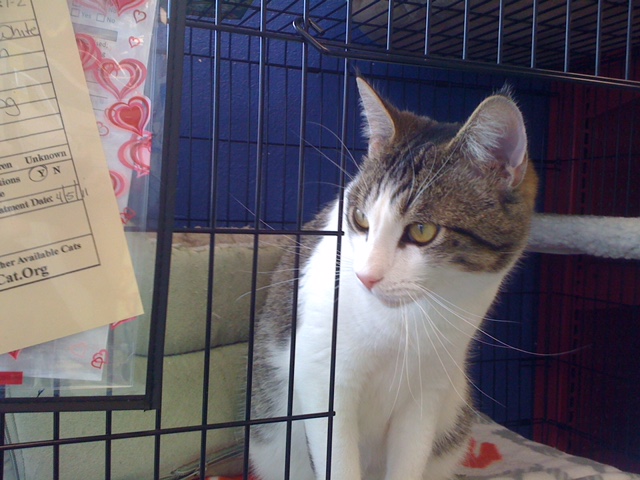 Zee waiting to come home, April 2011
Zee waiting to come home, April 2011
ZEE ACCLIMATES QUICKLY
While we were advised it might take a couple of weeks for Zee to be comfortable in her new home, Zee accepted us instantly. Over the coming months, we adopted two more cats.
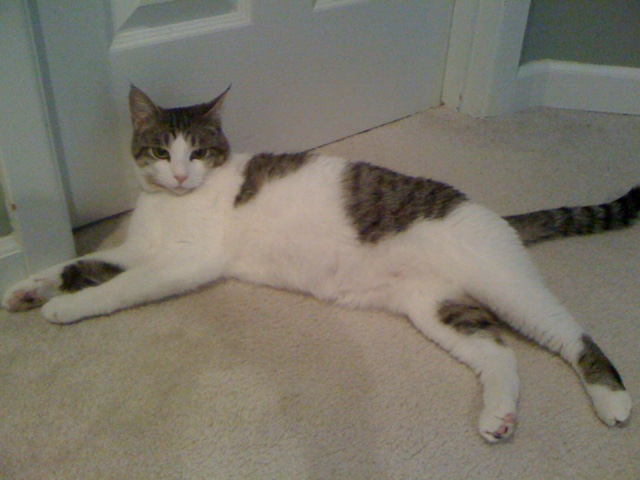 Zee relaxing after arriving in her new home
Zee relaxing after arriving in her new home
ZEE GAINS AND LOSES A BEST FRIEND
After bringing home Dublin, a six month old kitten, Zee adopted him as her own. The two were inseperable. Dublin became ill with FIP, an incurable and fatal illness resulting from the mutation of a common virus. We fought for him, and obtained access to experimental medication through the University of Tennessee. We got more time, but when the seizures started, it was sadly time to let him go. When I came home from Dublin's last trip to the vet, Zee licked the tears from my face. She layed by my side and comforted me through the night.
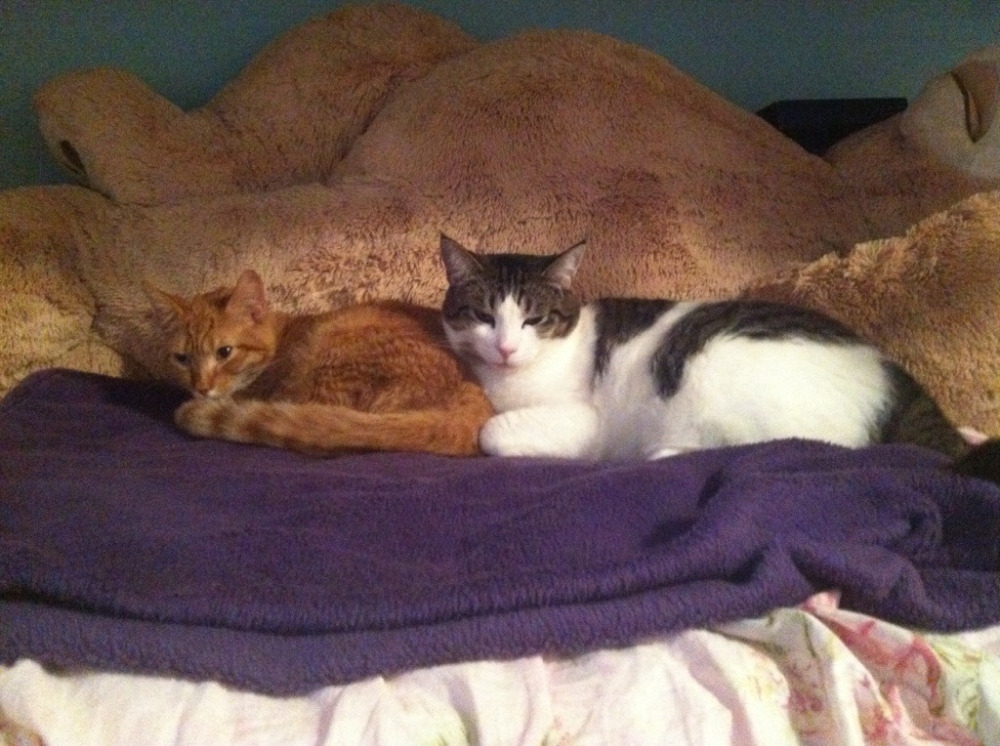 Zee and Dublin, January 2012
Zee and Dublin, January 2012
ZEE DEPRESSED OVER LOSS OF DUBLIN
Zee was saddened by the loss of her friend. She became sluggish and was uninterested in playing. I brought her to the vet several times, but they could find nothing wrong with her. She eventually coughed up some hairballs, and her energy levels improved. We adopted additional cats, one of which became Zee's playmate, and Zee resumed a fairly normal life. Still, she was not the same cat that loved to frolic around the house with Dublin. In retrospect, I now know this is when her health issues started. But it would be two more years until a proper diagnosis. Two years while Zee's kidneys were silently deteriorating.
A CRASH COURSE IN KIDNEY DISEASE
Chronic renal failure (kidney disease) is a leading cause of death in domestic cats. One in three cats may develop chronic kidney disease over their lifetime. Kidneys have built in reserve capacity; sadly, symptoms may not appear, and bloodwork will be normal, until two thirds of kidney function has been lost. Additional loss will result in toxins building up in the bloodstream, at which point symptoms may appear and bloodwork will be abnormal.
SUMMER 2014 CRISIS
In June of 2014, Zee slowed down significantly. She constantly asked me to hold her and started to look very unwell. I brought her to a nearby emergency vet, who found she had a lacerated paw, likely from a fight with another cat. She was dehydrated, and blood results showed her kidney values were dramaticaly elevated. She spent two nights in the hospital receiving intravenous fluids. Her kidney values came down, but were still well out of normal range.
DEVASTATING NEWS
I came to visit Zee just after a repeat blood test, and was given devastating news. Her red blood cell count was dangerously low, and she was misdiagnosed with Disseminated Intravascular Coagulation (DIC) and effectively given a death sentence. Without sufficient red blood cells, oxygen could not be transported throughout her body, and she would soon die. Her only chance at survival was an immediate blood transfusion, and to make matters worse, Zee was found to have type B blood, a rare bloodtype only seen in an extremely small percentage of cats. None of this blood was available. Zee was given less than a 5% chance of survival, and it was recommended that she be euthanized. I looked into Zee's eyes, as well as my heart, and knew what I had to do. Zee was an amazing cat and an important part of our family; I would not lose her without a fight.
FIGHTING FOR ZEE'S LIFE
I transferred Zee to DoveLewis, a state of the art animal hospital in Portland, Oregon. They determined that Zee did not have DIC, and not in immediate need of a blood transfusion, but was still critically ill. A battery of tests was performed, and chronic kidney disease was confirmed. She remained in the hospital on intravenous fluids. Her red blood cell count continued to drop, and by the third day, the blood transfusion was required.
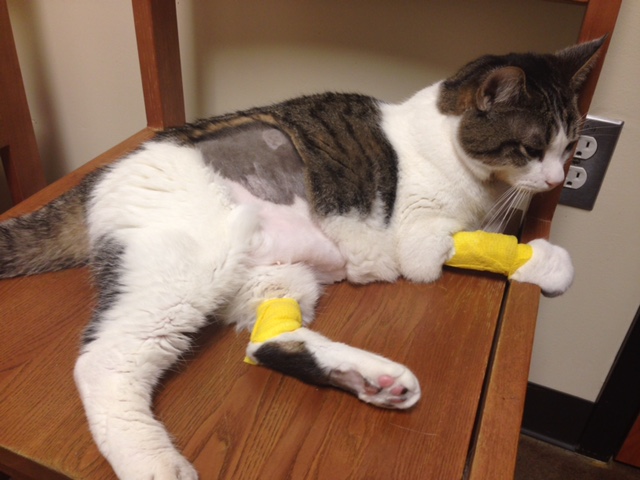 Visiting Zee at DoveLewis. Her fur was shaved to perform an ultrasound exam
Visiting Zee at DoveLewis. Her fur was shaved to perform an ultrasound exam
BLOOD TRANSFUSION REQUIRED - NO BLOOD AVAILABLE
DoveLewis has an onsite donor colony, for situations like this where a life saving blood transfusion is required. But there was only one type B cat in this colony, and that cat had recently donated. It would be several more weeks until that cat could donate again.
AN ANONYMOUS DONOR GIVES ZEE A CHANCE AT LIFE
DoveLewis also maintains a roster of outside cats that are available for blood donations. On extremly short notice, a type B cat was brought to the hospital. This unsung hero provided a single unit of blood, which was all that stood between Zee's chance at life and certain death. Zee is in critical condition, and may not survive the night.
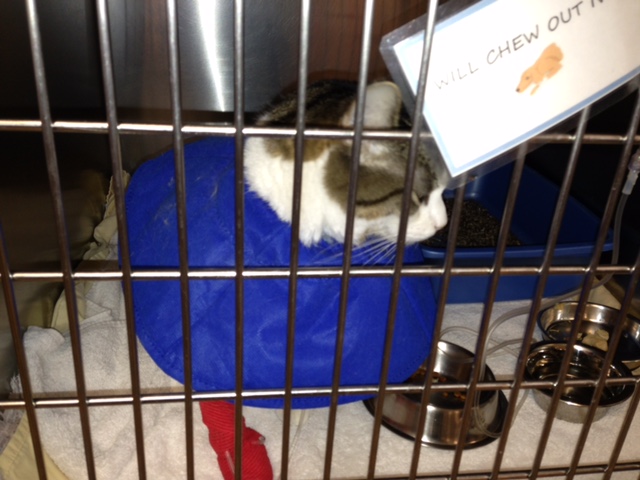 Zee at DoveLewis awaiting a life saving blood transfusion
Zee at DoveLewis awaiting a life saving blood transfusion
ZEE SURVIVES
I received updates throughout the night, and visited Zee in the morning. Zee tolerated the blood transfusion well, had no adverse reactions, and her red blood cell count has begun to rise. Zee has survived her crisis, and will live to see another day, but our fight has just begun.
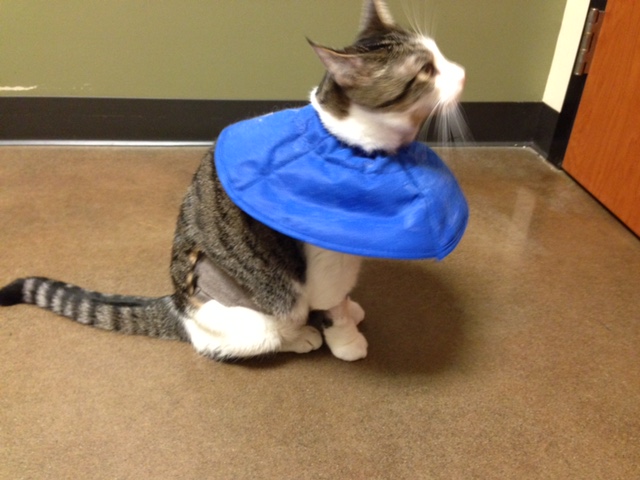 Zee the morning after her blood transfusion
Zee the morning after her blood transfusion
ZEE RETURNS HOME
Zee was discharged from the hospital, provided with antibiotics and a prescription diet, and given a referral to an internal medicine specialist. My education into medical specialists for animals is about to begin. Zee will eventually have an internist, cardiologist, surgeon, anethesiologist, dentist, and acupuncturist.
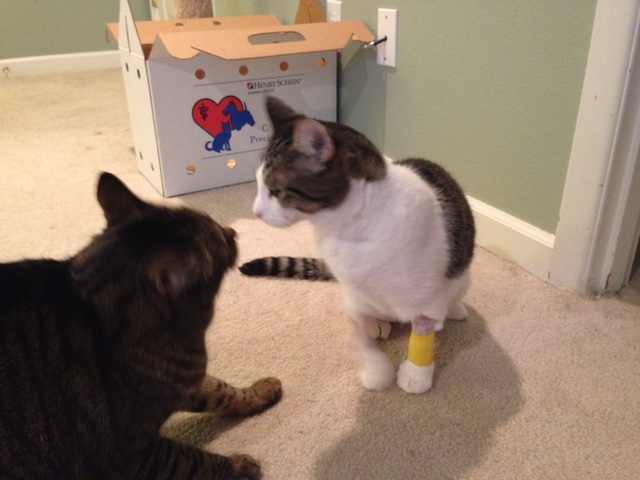 Zee reunites with Mowgli after returning home from DoveLewis
Zee reunites with Mowgli after returning home from DoveLewis
THE CAT WHISPERER GIVES ZEE A NEW LEASE ON LIFE
Soon after Zee returned home, she went into a slump. She hid in my bedroom closet inside a tipped over shopping bag. She would occassionally come out, standing very still, and would return to the bag. Zee would not eat or drink. She wanted nothing to do with life, and I feared I was losing her. I called the woman who ran the shelter Zee was adopted from, and she came over within the hour.
She and Zee had not seen each other for several years. The cat whisperer got on her belly, and pulled herself up to the shopping bag that Zee was hiding in. Zee came alive in her presence, as she reinstilled Zee's will to live. She helped make some changes in Zee's environment, and set up a perch for Zee to look out the window.
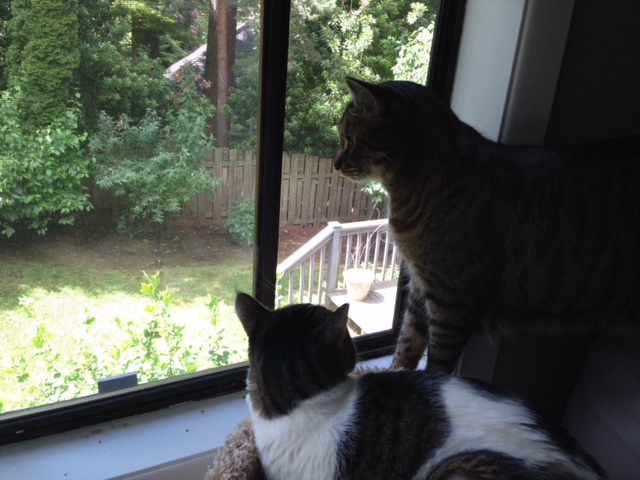 Zee and Mowgli share a moment admiring the view
Zee and Mowgli share a moment admiring the view
WHO IS THIS MYSTERIOUS STRANGER?
Days after Zee's return home, a sweet orange boy came a calling. Zee seems to know him and appears smitten. I later learn he lives on the next block and was born shortly after Dublin's departure. I feel like I know him too. After this encounter, Zee's energy levels begin to rise. Her desire to live has ratcheted up another notch.
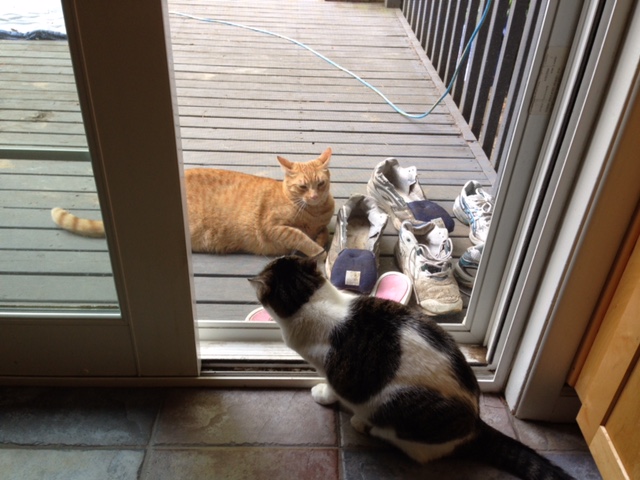 Zee takes an instant liking to this visiting cat
Zee takes an instant liking to this visiting cat
ZEE'S SPECIALTY TREATMENT BEGINS
It is two weeks before we can see the internal medicine specialist. She examines Zee and diagnoses her with stage 3 kidney disease, with a median survival time of 778 days. But when additional testing shows she is losing protein in her urine, median survival time is reduced to 276 days. She also sees a slightly enlarged heart on xray, and refers Zee to a cardiologist. After an echocardiogram, Zee has an additional diagnosis of hypertrophic cardiomyopathy, which is a thickening of the heart muscle. Zee is prescribed Benazepril, which should both reduce her protein loss and decrease the load on her heart. Zee's blood and urine are rechecked every few weeks. Her labs are improving, and she is gaining a bit of weight.
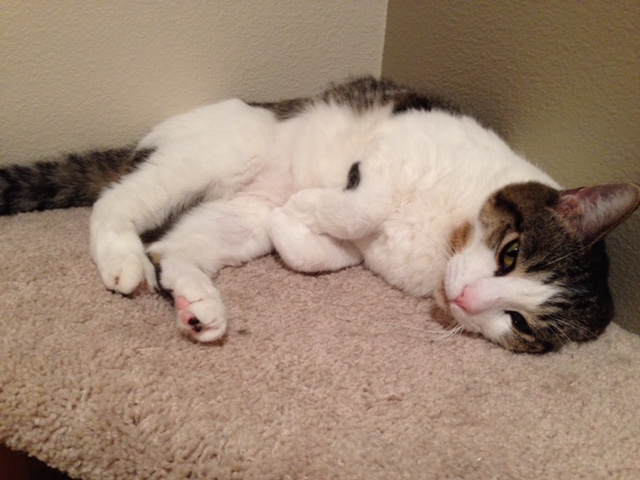 Zee relaxing after several weeks of medical treatment
Zee relaxing after several weeks of medical treatment
KIDNEY TRANSPLANT IS A POTENTIAL OPTION
After a great deal of research, I learn of a couple of options for Zee. Kidney transplants are available for cats, but strict criteria must be met. I am concerned that Zee's heart issues would preclude transplant. The doctor who perfected the procedure reviews Zee's echocardiogram and determines her heart is strong enough for a transplant. But Zee's current condition is too good to allow a transplant. She must be sick enough to require it, but well enough to survive the procedure. If and when the day comes, I will travel to University of Pennsylvania with one cat, and come home with two. I would adopt the donor cat and promise that cat a lifelong home.
STEM CELLS, AN EXPERIMENTAL TREATMENT
I also learn of research studies at the University of Colorado involving the use of stem cells to treat kidney disease. I review the studies, and feel they show promise. I have several conversations with Vet-Stem, a San Diego based biotech company. They have created technology to extract stem cells from abdominal fat, and create stem cell doses that are injected into the bloodstream. The use of stem cells for treatment of kidney disease has not been approved by the US Food and Drug Administration, but I receive a compassionate use exception to provide this treatment to Zee.
The specialty clinic treating Zee has performed stem cell therapy on dogs having muscle and joint issues, injecting stem cells directly into the affected tissue. They have never treated a cat with stem cells, and are skeptical that it will make a difference. I am determined to give Zee every chance she has, and want to proceed. They agree to perform the procedure.
THE STEM CELL HARVEST
Zee is scheduled to undergo a stem cell harvest. This is a surgical procedure in which an abdominal incision will be made, and several grams of fat extracted. This fat will be shipped overnight to Vet-Stem, who will process this fat to obtain the stem cells. These stem cells will be divided into multiple doses, some of which will be frozen for later use. They also create what they call a retention sample, from which additional stem cells can be cultured. Zee will require one harvest, and will have stem cells available for life. Because of Zee's kidney issues, an anesthesiologist is required to monitor Zee throughout the surgical procedure. Processed stem cells will arrive two days after the harvest.
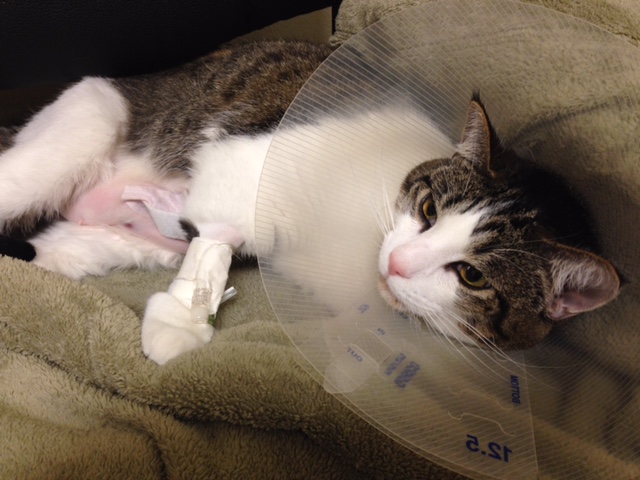 Zee recovering after her stem cell harvest
Zee recovering after her stem cell harvest
THE STEM CELL INFUSION
Zee came home the day of surgery, and returned to the clinic two days later for her first stem cell infusion. She is observed for several hours after the stem cells are injected into her bloodstream, after which she comes home again. Her second infusion will come two weeks later.
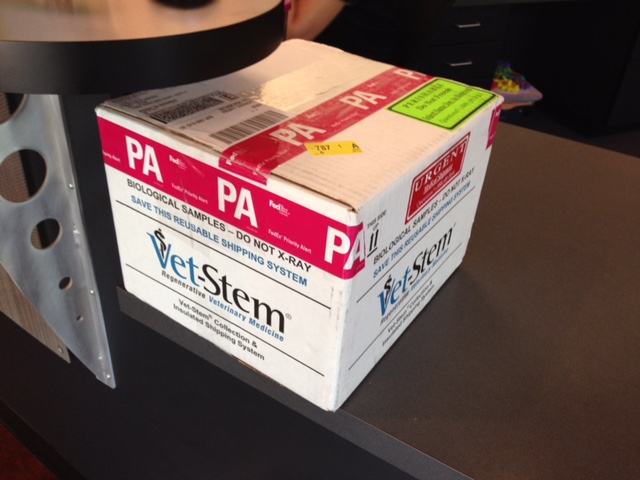 Zee's stem cells arrive
Zee's stem cells arrive
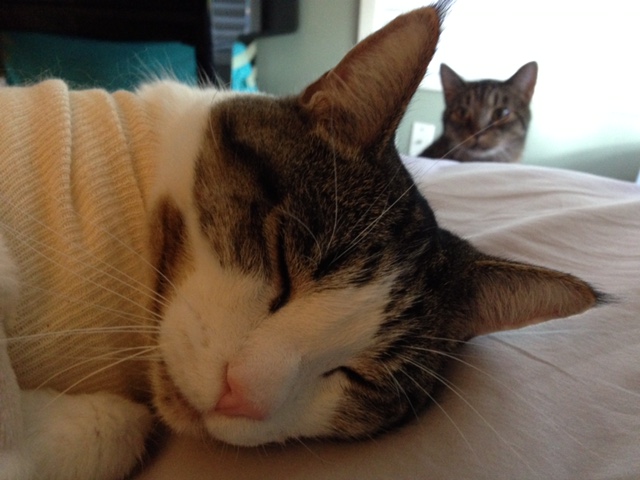 Mowgli lets Zee rest after her first stem cell infusion
Mowgli lets Zee rest after her first stem cell infusion
THE STEM CELLS ARE WORKING!
Zee has frequent monitoring of her blood and urine over the coming months. The items being monitored in her blood are creatinine and BUN, measures of the toxins in her bloodstream. Lower numbers are better, and they drop significantly. Her kidneys are operating more efficiently, and her creatinine is registering at the upper end of normal. Her energy levels have improved dramatically, she is active, and continuing to gain weight.
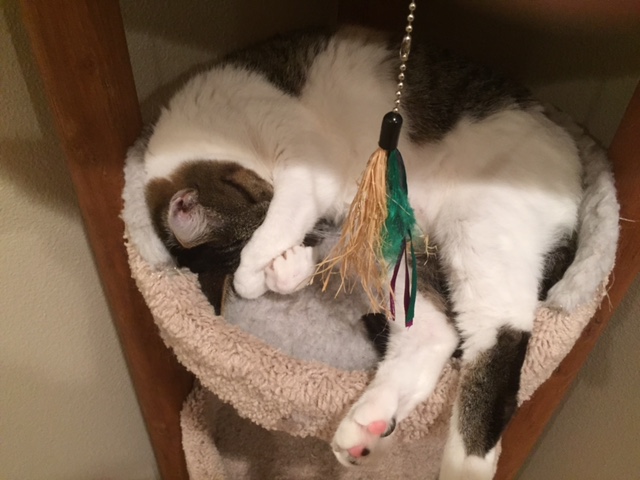 Zee camera shy after all the attention she's been getting
Zee camera shy after all the attention she's been getting
CONTINUED TREATMENT REQUIRED
By early 2015, Zee was better than ever. But chronic kidney disease is progressive, and I needed to remain vigilent with her treatment. Without treatment she will worsen. It is a battle, that we currently are winning. I continued my research to see what else I could do for her, and was surprised by what I found.
ACUPUNCTURE FOR CATS
I learned that acupuncture has been used to treat chronic kidney disease in cats. I continued to research this and contacted some holistic vets in the area. One in particular stood out, and I made an appointment for Zee and I to meet her. I knew immediately that I made the right choice, and Zee had her first acupuncture treatment. The initial result was nothing short of amazing. Within miniutes of arriving home, Zee had a very distinct response to her treatment.
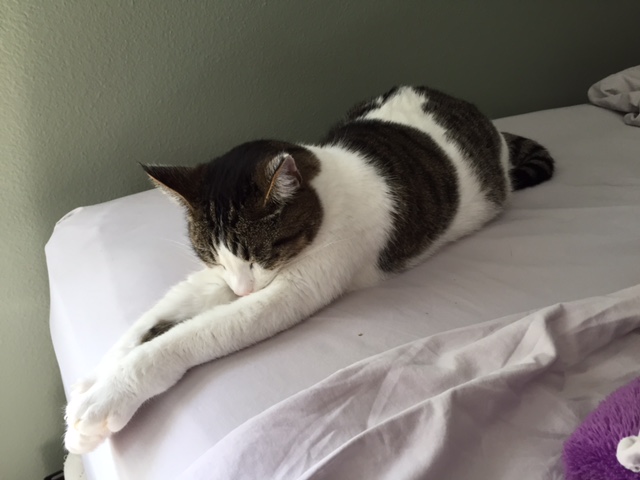 Zee relaxing after first acupuncture treatment
Zee relaxing after first acupuncture treatment
CURRENT TREATMENT AND CONDITION
Zee continues to get regular acupuncture treatments, and will get additional stem cell infusions as needed. She requires regular monitoring by both her internist and cardiologist. I also give her a daily probiotic, which can help metabolize toxic waste in the gut, before it hits the bloodstream. Zee continues on prescription medication and a prescription diet. The holistic vet also suggested a nutritional supplement that Zee receives twice daily. Zee has continued to improve dramatically, and the need for a kidney transplant seems unlikely in the near future. Since the start of acupuncture, Zee has gained 0.8 pounds, and her urine protein to creatinine ratio has decreased by 66%.
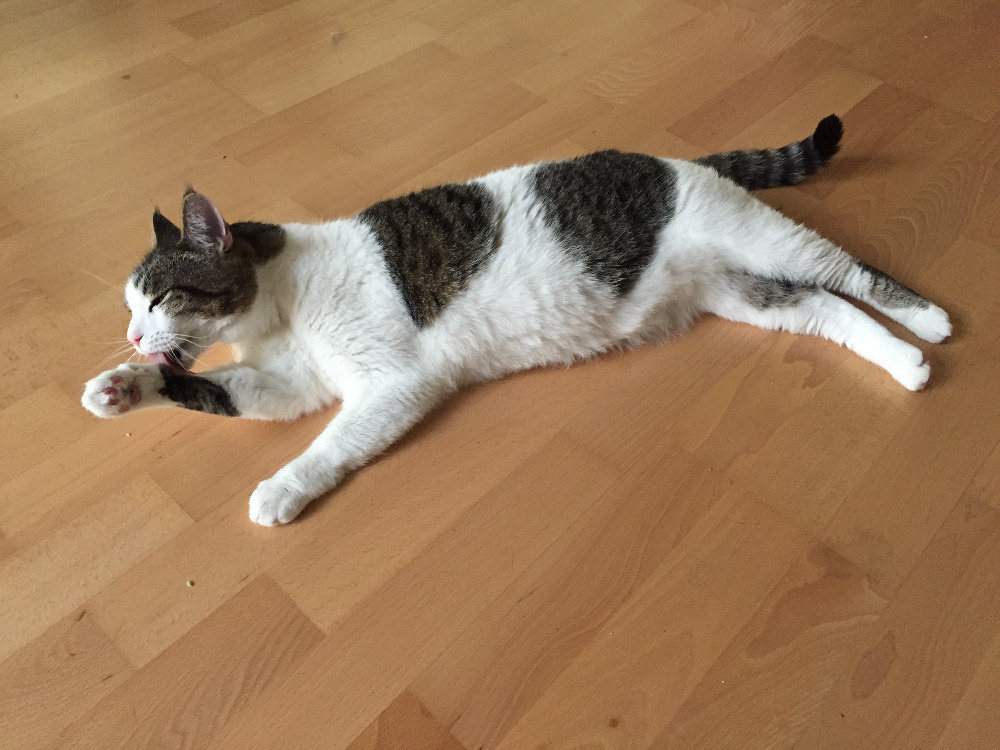 Zee after several months of acupuncture
Zee after several months of acupuncture
LOVE CONQUERS ALL
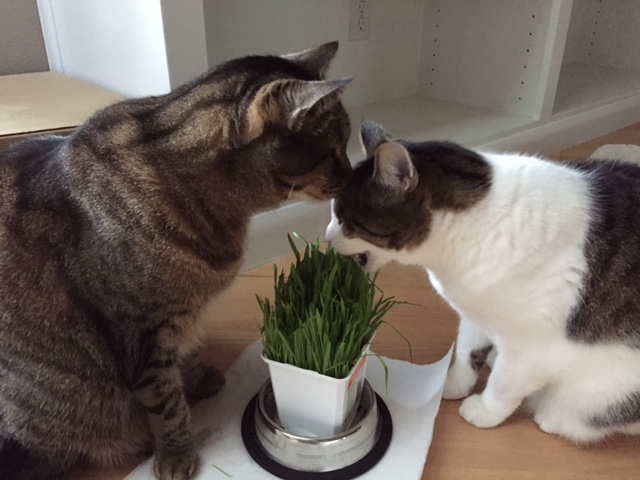 Zee and Mowgli enjoy a healthy snack together
Zee and Mowgli enjoy a healthy snack together
AS FOR ZEE'S VISITOR...
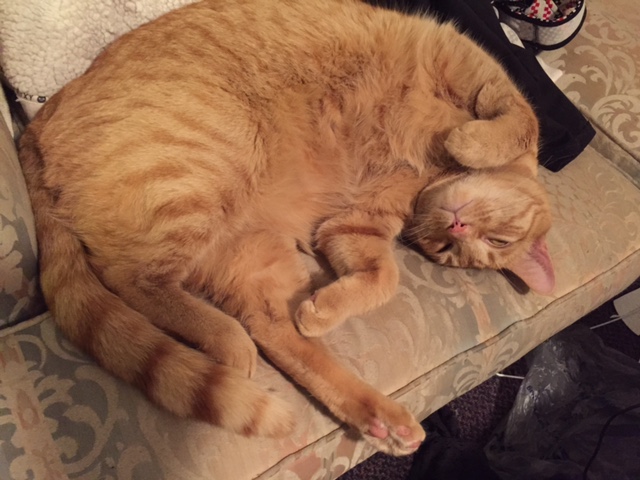 Sometimes cats choose where to live. We love him dearly, and so does Zee.
Sometimes cats choose where to live. We love him dearly, and so does Zee.
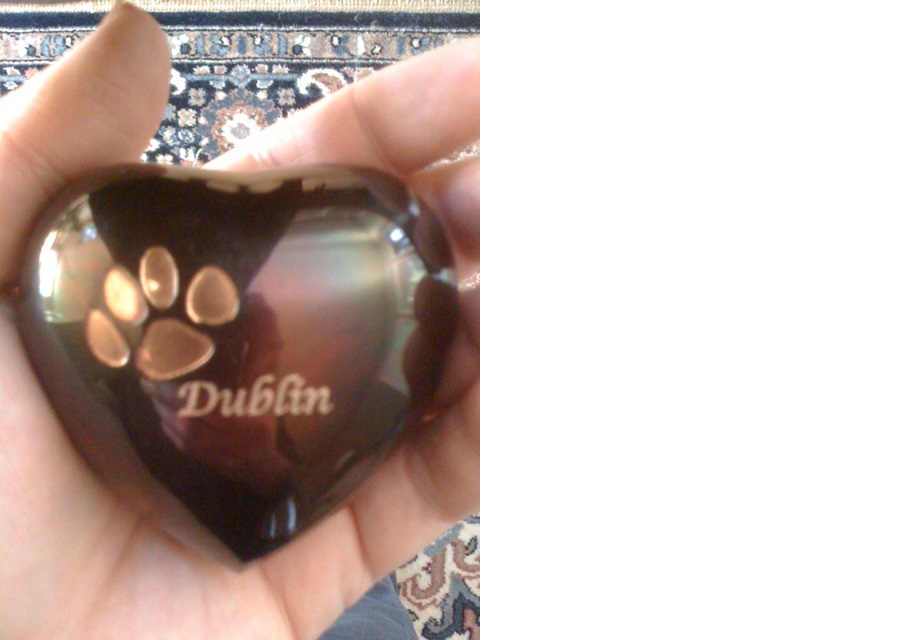 Dublin in our heart and never forgotten
Dublin in our heart and never forgotten
Thank you for reading.
Zee has been a remarkable cat since the day we adopted her in early 2011. She has brought great joy to the lives of all she has touched. Zee became seriously ill during the summer of 2014. Only four years old, she was given a 5% chance of survival, and it was recommended that she be euthanized. I could not let her go, learned all I could about her illness, and assembled a top notch medical team that has managed to restore her good health. She has had a blood transfusion, multiple stem cell infusions, and is currently receiving acupuncture treatments. She is also on daily medication, nutritional supplements, and a prescription diet. Expenses to date have been substantial, and today she is happy, active, and thriving. But ongoing care is required to monitor and maintain her condition, and she may require a kidney transplant in the future. Please consider a donation of $5 to help defray the cost of Zee’s ongoing care, and sharing Zee’s amazing journey with your friends and family.
ZEE COMES HOME WITH US
Zee was the first of several cats we adopted through a local shelter. I went to the store for rabbit food, and fell in love with Zee. We brought her home, and she instantly enriched our lives.
 Zee waiting to come home, April 2011
Zee waiting to come home, April 2011ZEE ACCLIMATES QUICKLY
While we were advised it might take a couple of weeks for Zee to be comfortable in her new home, Zee accepted us instantly. Over the coming months, we adopted two more cats.
 Zee relaxing after arriving in her new home
Zee relaxing after arriving in her new homeZEE GAINS AND LOSES A BEST FRIEND
After bringing home Dublin, a six month old kitten, Zee adopted him as her own. The two were inseperable. Dublin became ill with FIP, an incurable and fatal illness resulting from the mutation of a common virus. We fought for him, and obtained access to experimental medication through the University of Tennessee. We got more time, but when the seizures started, it was sadly time to let him go. When I came home from Dublin's last trip to the vet, Zee licked the tears from my face. She layed by my side and comforted me through the night.
 Zee and Dublin, January 2012
Zee and Dublin, January 2012ZEE DEPRESSED OVER LOSS OF DUBLIN
Zee was saddened by the loss of her friend. She became sluggish and was uninterested in playing. I brought her to the vet several times, but they could find nothing wrong with her. She eventually coughed up some hairballs, and her energy levels improved. We adopted additional cats, one of which became Zee's playmate, and Zee resumed a fairly normal life. Still, she was not the same cat that loved to frolic around the house with Dublin. In retrospect, I now know this is when her health issues started. But it would be two more years until a proper diagnosis. Two years while Zee's kidneys were silently deteriorating.
A CRASH COURSE IN KIDNEY DISEASE
Chronic renal failure (kidney disease) is a leading cause of death in domestic cats. One in three cats may develop chronic kidney disease over their lifetime. Kidneys have built in reserve capacity; sadly, symptoms may not appear, and bloodwork will be normal, until two thirds of kidney function has been lost. Additional loss will result in toxins building up in the bloodstream, at which point symptoms may appear and bloodwork will be abnormal.
SUMMER 2014 CRISIS
In June of 2014, Zee slowed down significantly. She constantly asked me to hold her and started to look very unwell. I brought her to a nearby emergency vet, who found she had a lacerated paw, likely from a fight with another cat. She was dehydrated, and blood results showed her kidney values were dramaticaly elevated. She spent two nights in the hospital receiving intravenous fluids. Her kidney values came down, but were still well out of normal range.
DEVASTATING NEWS
I came to visit Zee just after a repeat blood test, and was given devastating news. Her red blood cell count was dangerously low, and she was misdiagnosed with Disseminated Intravascular Coagulation (DIC) and effectively given a death sentence. Without sufficient red blood cells, oxygen could not be transported throughout her body, and she would soon die. Her only chance at survival was an immediate blood transfusion, and to make matters worse, Zee was found to have type B blood, a rare bloodtype only seen in an extremely small percentage of cats. None of this blood was available. Zee was given less than a 5% chance of survival, and it was recommended that she be euthanized. I looked into Zee's eyes, as well as my heart, and knew what I had to do. Zee was an amazing cat and an important part of our family; I would not lose her without a fight.
FIGHTING FOR ZEE'S LIFE
I transferred Zee to DoveLewis, a state of the art animal hospital in Portland, Oregon. They determined that Zee did not have DIC, and not in immediate need of a blood transfusion, but was still critically ill. A battery of tests was performed, and chronic kidney disease was confirmed. She remained in the hospital on intravenous fluids. Her red blood cell count continued to drop, and by the third day, the blood transfusion was required.
 Visiting Zee at DoveLewis. Her fur was shaved to perform an ultrasound exam
Visiting Zee at DoveLewis. Her fur was shaved to perform an ultrasound examBLOOD TRANSFUSION REQUIRED - NO BLOOD AVAILABLE
DoveLewis has an onsite donor colony, for situations like this where a life saving blood transfusion is required. But there was only one type B cat in this colony, and that cat had recently donated. It would be several more weeks until that cat could donate again.
AN ANONYMOUS DONOR GIVES ZEE A CHANCE AT LIFE
DoveLewis also maintains a roster of outside cats that are available for blood donations. On extremly short notice, a type B cat was brought to the hospital. This unsung hero provided a single unit of blood, which was all that stood between Zee's chance at life and certain death. Zee is in critical condition, and may not survive the night.
 Zee at DoveLewis awaiting a life saving blood transfusion
Zee at DoveLewis awaiting a life saving blood transfusionZEE SURVIVES
I received updates throughout the night, and visited Zee in the morning. Zee tolerated the blood transfusion well, had no adverse reactions, and her red blood cell count has begun to rise. Zee has survived her crisis, and will live to see another day, but our fight has just begun.
 Zee the morning after her blood transfusion
Zee the morning after her blood transfusionZEE RETURNS HOME
Zee was discharged from the hospital, provided with antibiotics and a prescription diet, and given a referral to an internal medicine specialist. My education into medical specialists for animals is about to begin. Zee will eventually have an internist, cardiologist, surgeon, anethesiologist, dentist, and acupuncturist.
 Zee reunites with Mowgli after returning home from DoveLewis
Zee reunites with Mowgli after returning home from DoveLewisTHE CAT WHISPERER GIVES ZEE A NEW LEASE ON LIFE
Soon after Zee returned home, she went into a slump. She hid in my bedroom closet inside a tipped over shopping bag. She would occassionally come out, standing very still, and would return to the bag. Zee would not eat or drink. She wanted nothing to do with life, and I feared I was losing her. I called the woman who ran the shelter Zee was adopted from, and she came over within the hour.
She and Zee had not seen each other for several years. The cat whisperer got on her belly, and pulled herself up to the shopping bag that Zee was hiding in. Zee came alive in her presence, as she reinstilled Zee's will to live. She helped make some changes in Zee's environment, and set up a perch for Zee to look out the window.
 Zee and Mowgli share a moment admiring the view
Zee and Mowgli share a moment admiring the viewWHO IS THIS MYSTERIOUS STRANGER?
Days after Zee's return home, a sweet orange boy came a calling. Zee seems to know him and appears smitten. I later learn he lives on the next block and was born shortly after Dublin's departure. I feel like I know him too. After this encounter, Zee's energy levels begin to rise. Her desire to live has ratcheted up another notch.
 Zee takes an instant liking to this visiting cat
Zee takes an instant liking to this visiting catZEE'S SPECIALTY TREATMENT BEGINS
It is two weeks before we can see the internal medicine specialist. She examines Zee and diagnoses her with stage 3 kidney disease, with a median survival time of 778 days. But when additional testing shows she is losing protein in her urine, median survival time is reduced to 276 days. She also sees a slightly enlarged heart on xray, and refers Zee to a cardiologist. After an echocardiogram, Zee has an additional diagnosis of hypertrophic cardiomyopathy, which is a thickening of the heart muscle. Zee is prescribed Benazepril, which should both reduce her protein loss and decrease the load on her heart. Zee's blood and urine are rechecked every few weeks. Her labs are improving, and she is gaining a bit of weight.
 Zee relaxing after several weeks of medical treatment
Zee relaxing after several weeks of medical treatmentKIDNEY TRANSPLANT IS A POTENTIAL OPTION
After a great deal of research, I learn of a couple of options for Zee. Kidney transplants are available for cats, but strict criteria must be met. I am concerned that Zee's heart issues would preclude transplant. The doctor who perfected the procedure reviews Zee's echocardiogram and determines her heart is strong enough for a transplant. But Zee's current condition is too good to allow a transplant. She must be sick enough to require it, but well enough to survive the procedure. If and when the day comes, I will travel to University of Pennsylvania with one cat, and come home with two. I would adopt the donor cat and promise that cat a lifelong home.
STEM CELLS, AN EXPERIMENTAL TREATMENT
I also learn of research studies at the University of Colorado involving the use of stem cells to treat kidney disease. I review the studies, and feel they show promise. I have several conversations with Vet-Stem, a San Diego based biotech company. They have created technology to extract stem cells from abdominal fat, and create stem cell doses that are injected into the bloodstream. The use of stem cells for treatment of kidney disease has not been approved by the US Food and Drug Administration, but I receive a compassionate use exception to provide this treatment to Zee.
The specialty clinic treating Zee has performed stem cell therapy on dogs having muscle and joint issues, injecting stem cells directly into the affected tissue. They have never treated a cat with stem cells, and are skeptical that it will make a difference. I am determined to give Zee every chance she has, and want to proceed. They agree to perform the procedure.
THE STEM CELL HARVEST
Zee is scheduled to undergo a stem cell harvest. This is a surgical procedure in which an abdominal incision will be made, and several grams of fat extracted. This fat will be shipped overnight to Vet-Stem, who will process this fat to obtain the stem cells. These stem cells will be divided into multiple doses, some of which will be frozen for later use. They also create what they call a retention sample, from which additional stem cells can be cultured. Zee will require one harvest, and will have stem cells available for life. Because of Zee's kidney issues, an anesthesiologist is required to monitor Zee throughout the surgical procedure. Processed stem cells will arrive two days after the harvest.
 Zee recovering after her stem cell harvest
Zee recovering after her stem cell harvestTHE STEM CELL INFUSION
Zee came home the day of surgery, and returned to the clinic two days later for her first stem cell infusion. She is observed for several hours after the stem cells are injected into her bloodstream, after which she comes home again. Her second infusion will come two weeks later.
 Zee's stem cells arrive
Zee's stem cells arrive Mowgli lets Zee rest after her first stem cell infusion
Mowgli lets Zee rest after her first stem cell infusionTHE STEM CELLS ARE WORKING!
Zee has frequent monitoring of her blood and urine over the coming months. The items being monitored in her blood are creatinine and BUN, measures of the toxins in her bloodstream. Lower numbers are better, and they drop significantly. Her kidneys are operating more efficiently, and her creatinine is registering at the upper end of normal. Her energy levels have improved dramatically, she is active, and continuing to gain weight.
 Zee camera shy after all the attention she's been getting
Zee camera shy after all the attention she's been gettingCONTINUED TREATMENT REQUIRED
By early 2015, Zee was better than ever. But chronic kidney disease is progressive, and I needed to remain vigilent with her treatment. Without treatment she will worsen. It is a battle, that we currently are winning. I continued my research to see what else I could do for her, and was surprised by what I found.
ACUPUNCTURE FOR CATS
I learned that acupuncture has been used to treat chronic kidney disease in cats. I continued to research this and contacted some holistic vets in the area. One in particular stood out, and I made an appointment for Zee and I to meet her. I knew immediately that I made the right choice, and Zee had her first acupuncture treatment. The initial result was nothing short of amazing. Within miniutes of arriving home, Zee had a very distinct response to her treatment.
 Zee relaxing after first acupuncture treatment
Zee relaxing after first acupuncture treatmentCURRENT TREATMENT AND CONDITION
Zee continues to get regular acupuncture treatments, and will get additional stem cell infusions as needed. She requires regular monitoring by both her internist and cardiologist. I also give her a daily probiotic, which can help metabolize toxic waste in the gut, before it hits the bloodstream. Zee continues on prescription medication and a prescription diet. The holistic vet also suggested a nutritional supplement that Zee receives twice daily. Zee has continued to improve dramatically, and the need for a kidney transplant seems unlikely in the near future. Since the start of acupuncture, Zee has gained 0.8 pounds, and her urine protein to creatinine ratio has decreased by 66%.
 Zee after several months of acupuncture
Zee after several months of acupunctureLOVE CONQUERS ALL
 Zee and Mowgli enjoy a healthy snack together
Zee and Mowgli enjoy a healthy snack togetherAS FOR ZEE'S VISITOR...
 Sometimes cats choose where to live. We love him dearly, and so does Zee.
Sometimes cats choose where to live. We love him dearly, and so does Zee. Dublin in our heart and never forgotten
Dublin in our heart and never forgottenThank you for reading.
Organizer
Steve Munt
Organizer
Lake Oswego, OR